Unit 4: Reporting
| Site: | OpenLearn Create |
| Course: | Introduction to Safeguarding in the International Aid Sector |
| Book: | Unit 4: Reporting |
| Printed by: | Guest user |
| Date: | Tuesday, 25 November 2025, 3:11 PM |
Table of contents
- The reporting stage of the Safeguarding Cycle
- 4.1 Common barriers to reporting safeguarding concerns
- 4.2 Barriers to reporting for children
- 4.3 Barriers to reporting for vulnerable survivors
- 4.4 Barriers to reporting for organisation staff
- 4.5 How can the barriers to reporting be overcome?
- 4.6 What would we want?
- 4.7 Reporting frameworks
- 4.8 What should a reporting mechanism look like?
- 4.9 Is your organisational reporting mechanism fit for purpose?
- 4.10 Community-based complaint response mechanism
- 4.11 How to set up a CRM?
- 4.12 Using a participatory approach to develop a CRM
- 4.13 How could you improve your organisation’s existing CRM?
- 4.14 Top Tips from around the world
- 4.15 What is the benefit of ensuring that your organisation has a CRM?
- 4.16 Reflecting on complaints response mechanisms in your organisation
- 4.17 Unit 4 Knowledge check
- 4.18 Review of Unit 4
The reporting stage of the Safeguarding Cycle
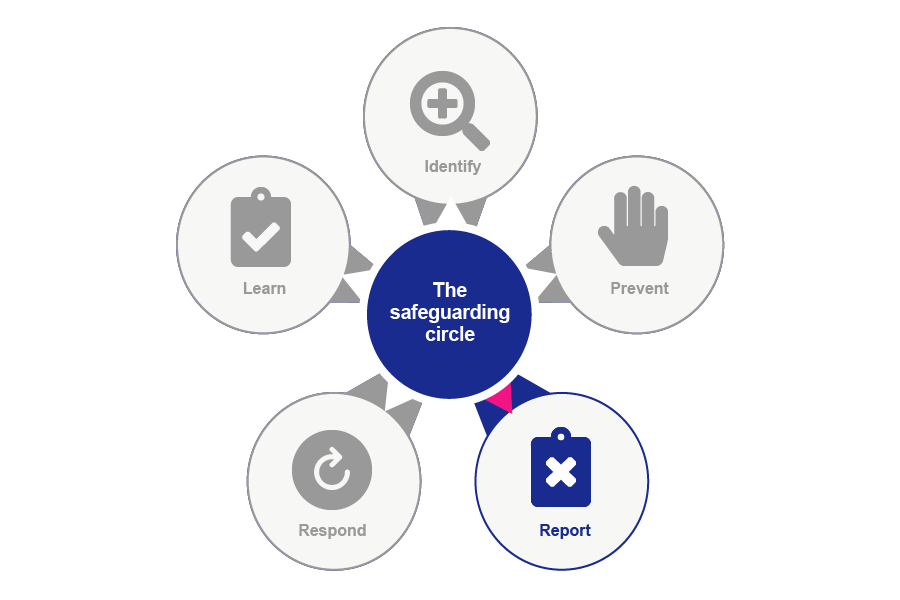
Congratulations! You’re nearly half-way through this introductory course on safeguarding in the international development sector.
As this course has highlighted so far, safeguarding is a difficult and emotive issue, and there are many potential hurdles, myths and barriers to raising concerns, which can prevent them from being dealt with appropriately.
We have covered two parts of the cycle already:
- Identify – how to identify the different types of harm arising from the misuse of power, the indicators of that harm, and examining the vulnerability of children, adults and those who work with and for our organisations.
- Prevent – how to recognise risks to the people that we work with, how to develop a risk assessment to think of the safeguarding measures to mitigate that risk, how to recruit safely, how to develop a Code of Conduct, and how to use images and data of beneficiaries safely.
In this part of the course, we return to the Safeguarding Cycle and look at the ‘Report’ stage – what are the common barriers to reporting, how to overcome some of these common barriers, and what we, as Safeguarding Leads for our organisations, need to do to provide safe and confidential reporting mechanisms, support those who do raise concerns and support survivors/victims through the process.
What do we mean by ‘reporting’? This is when someone raises their concerns about someone else’s behaviour which they find concerning and they believe that person or someone else may be in danger of harm because of that inappropriate behaviour. Reports may come through informal discussions but must be formalised in a written form for next steps to take place.
In this unit, we will also look at the internal process within an organisation, the different ways that reports can arise (such as through a community-based reporting mechanism) and how organisations can make reports externally to relevant authorities, using a survivor-centred approach.
4.1 Common barriers to reporting safeguarding concerns

© Dmitry Naumov / 123rf.com
|
What are the common barriers preventing reporting of abuse, exploitation and harassment in development agencies? Different people will experience different barriers to reporting. Think of the different barriers for the following people:
|
The next three activities will look at the experiences of children, vulnerable adults, and organisational staff.
4.2 Barriers to reporting for children
Children are able to discern whether a touch or event makes them feel uncomfortable or unsafe.
However, a lack of understanding due to age, developmental delay or disability may mean they are not always able to ascertain if the situation was abusive or not.
They may, however, be able to describe what has happened to someone they trust, even so it can be very risky for them and brave of them to take that step. Even when children know someone has abused their position, there are still barriers to listening to children when they disclose what happened to them.
|
Activity 4.1 One child’s experience Read the following short extract of one child’s experience and reflect and respond to the following questions in your learning journal:
Jacob: “My friend Daniel told the teacher Mrs Obi that when he went to the doctor for help with his coughing, the doctor made him take down his trousers and he touched him, down there. He said he felt bad, he didn’t like it. But Ms Obi said that we should not say such terrible lies because the doctors come to help the children every week for free. I tried to get him to go and tell someone else, but he just stopped talking about it.” |
4.3 Barriers to reporting for vulnerable survivors
This next video recalls the experiences of a vulnerable survivor of sexual abuse and exploitation who explains some of her reasons for not reporting.
|
Activity 4.2 Barriers faced by survivors Watch this video (from 8:26 to 9:38). Answer the following questions in your learning journal:
Here is a transcript of this section of the video. Trigger warning: The themes and content of the course can inevitably sometimes be disturbing. It is important that you are prepared for this and look after your own welfare, particularly when you watch or listen to the audio and visual material. |
4.4 Barriers to reporting for organisation staff
Organisational staff are also vulnerable to sexual exploitation, abuse and harassment but are often reluctant to report safeguarding concerns for fear of repercussions.
|
Activity 4.3 Why are aid agency staff are reluctant to report? The video above highlights the experience of a local staff member in the Democratic Republic of Congo. She was employed by a development agency who were working on the Ebola crisis. Listen to what happened to her and consider why aid agency staff are reluctant to report experiences of abuse and exploitation. Trigger warning: The themes and content of the course can inevitably sometimes be disturbing. It is important that you are prepared for this and look after your own welfare, particularly when you watch or listen to the audio and visual material. |
4.5 How can the barriers to reporting be overcome?

© Andrii Yalanskyi / 123rf.com
To ensure that we support a robust and confidential reporting mechanism in our organisation, we need to be more survivor centred.
|
Activity 4.4 Creating a culture that promotes trust and partnership Read these two articles which could provide you with some ideas of what being more survivor centred looks like:
Reflect and respond in your learning journal:
|
4.6 What would we want?
![]()
Sherine has a question: What should we be thinking about when we are considering barriers to reporting?
Watch the video above to find out.
4.7 Reporting frameworks
How to provide safe and confidential reporting mechanisms.
How confident are you about receiving reports of safeguarding concerns?
It is good practice for organisations to have a Designated Safeguarding Officer who has the authority to receive safeguarding concerns or reports and to take the appropriate next steps.
Many agencies have included mandatory reporting for staff and associated personnel, including partners, in their Codes of Conduct and contractual documents in an effort to improve the culture of accountability in their organisations by ensuring that there are consequences for inappropriate behaviour that breaches the Code of Conduct.
Consider the first question in this poll and give your opinions as you see it.
How confident are you about receiving reports of safeguarding concerns?
What would prevent someone in your organisation from raising a report?
Having considered how confident you are about receiving reports of safeguarding concerns, now consider the second question in this poll and give your opinions as you see it.
What would be the biggest barrier preventing someone in your organisation from raising a report?
4.8 What should a reporting mechanism look like?
![]()
Before you review in some detail the reporting mechanisms in your own organisation in the next activity, watch the video above in which Safeguarding Leads share their top tips for effective reporting mechanisms.
Organisations should have in place a clear and accessible reporting mechanism for safeguarding concerns to be reported. These should be open predominantly to staff and organisational personnel, including partners, to raise their concerns.
For a reporting mechanism to work and be effective, it should follow certain minimum standards. Examples of these include:
- A specific person designated to receive reports (often called a ‘Safeguarding Lead’ or ‘Safeguarding Officer’).
- Everyone knows and understands their responsibility to report safeguarding concerns.
- The availability of a confidential reporting and/or whistleblowing mechanism within or external to the organisation.
- A mechanism that be trusted and does not penalise those who raise concerns.
The next activity will help you think through how the current reporting mechanism in your organisation meets the standards within the international Enhanced Due Diligence principles developed by the UK Foreign Commonwealth & Development Office and the OECD Development Assistance Committee Recommendation on Ending SEAH.
4.9 Is your organisational reporting mechanism fit for purpose?
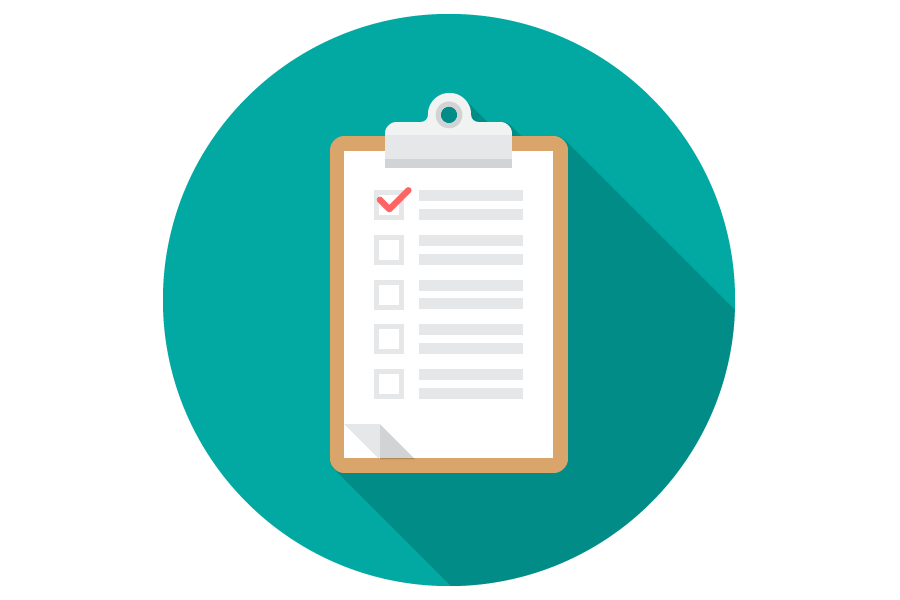
© Victor_85 / iStock / Getty Images Plus
|
Activity 4.5 Your organisational reporting mechanism Drawing on all your learning so far, study the example table below, which has four columns, and complete it for your organisation. You may want to discuss the details further with other people in your organisation. Column 1 – is a list of the criteria for an effective organisational reporting mechanism. Column 2 – is the reasons behind those criteria. Column 3 – has been left blank for you to complete on behalf of your organisation. If the criteria are ‘Met’, shade the box green; if they’re only ‘Partially met’, shade the box orange or amber; and if they’re ‘Not met’, shade the box in red. Or use different symbols: ‘–’ or ‘x’. Column 4 – make a note of the various areas in organisational policy, procedure or practice which can be improved. When you have completed the table, reflect on the exercise and consider these questions: What did you learn? What key improvements will you take forward in your organisation?
Here is a downloadable version of this table. |
![]()
Want to find out more?
If you are interested in reading more on reporting mechanisms, follow the links below:
Bond Safeguarding Report Handling Case Studies Resource
4.10 Community-based complaint response mechanism
How to develop or improve a complaint response mechanism (CRM) to receive safeguarding concerns.

© patpitchaya / iStock / Getty Images Plus
What is a CRM?
A complaints response mechanism is a way for communities who benefit from your organisational projects and activities to raise safeguarding concerns and complaints. Safeguarding concerns, however, do need to be dealt with differently from other complaints since such concerns are sensitive and confidential.
The Core Humanitarian Standard which you read in unit 3 is a standard that has been signed up to by many international organisations working in the humanitarian sector. There is both a short plain language and more detailed version of the nine commitments on the website.
Under Commitment 5, communities and people affected by crisis should have access to safe and responsive mechanisms to handle complaints. Complaints should be welcomed and addressed. This would include the principle that complaints regarding ‘programming, sexual exploitation and abuse, and other abuses of power’ are separated from other forms of project-based complaints and escalated immediately to the safeguarding focal points at field level and/or designated safeguarding officers at senior management level for them to be dealt with confidentially and in a timely way.
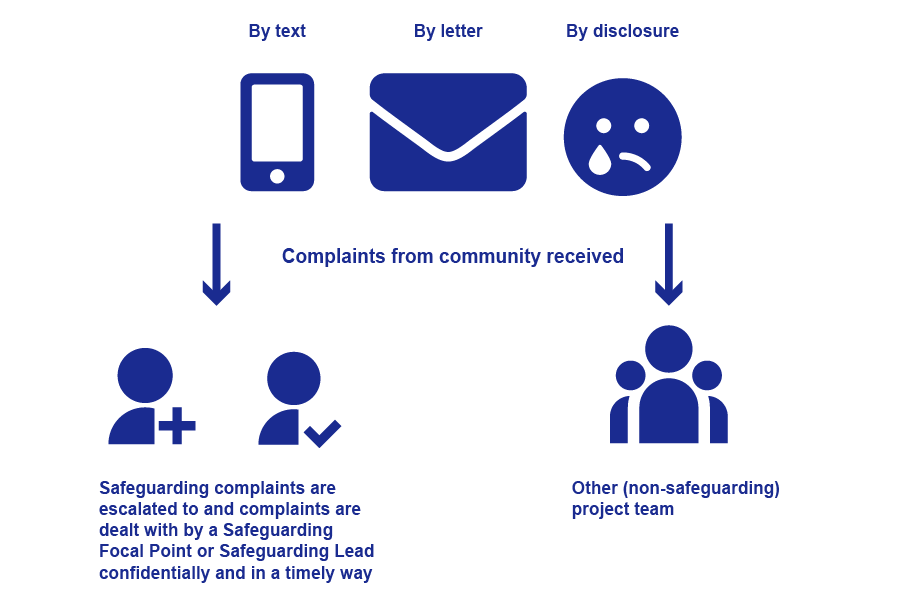
4.11 How to set up a CRM?
It’s imperative that organisations have in place a CRM that is accessible, confidential and trusted by staff, partners and beneficiaries. It is an important step to improve safeguarding in aid agencies.
|
Activity 4.6 Establishing a community-based CRM Watch this video on the importance of establishing a community-based CRM that is ready to receive safeguarding concerns from the community about the conduct of its staff and associated personnel. Consider these questions and note some of the key points in your learning journal:
|
For more guidance on setting up an effective CRM go to the resource below:
4.12 Using a participatory approach to develop a CRM
![]()
Hasan likes the idea of promoting a CRM to communities but would like to know what else to think about.
Watch the video above to learn more about using a participatory approach when developing a CRM in communities.
4.13 How could you improve your organisation’s existing CRM?
|
Activity 4.7 Obstacles to an effective CRM Read this article called Facing the facts of where we are at. It is an internal global review highlighting obstacles and opportunities for the Danish Refugee Council to address Commitment 5 of the Core Humanitarian Standard (CHS). Answer the following question in your learning journal:
|
4.14 Top Tips from around the world
![]()
Watch the video above.
You will hear from some Safeguarding Leads from various INGOs, who highlight important points in their structures and procedures.
Consider what further learning points there are for your own organisation.
It is good practice that organisations include communities in developing complaints response mechanisms and support different ways that they want to raise their concerns that they are comfortable with and will use.
4.15 What is the benefit of ensuring that your organisation has a CRM?
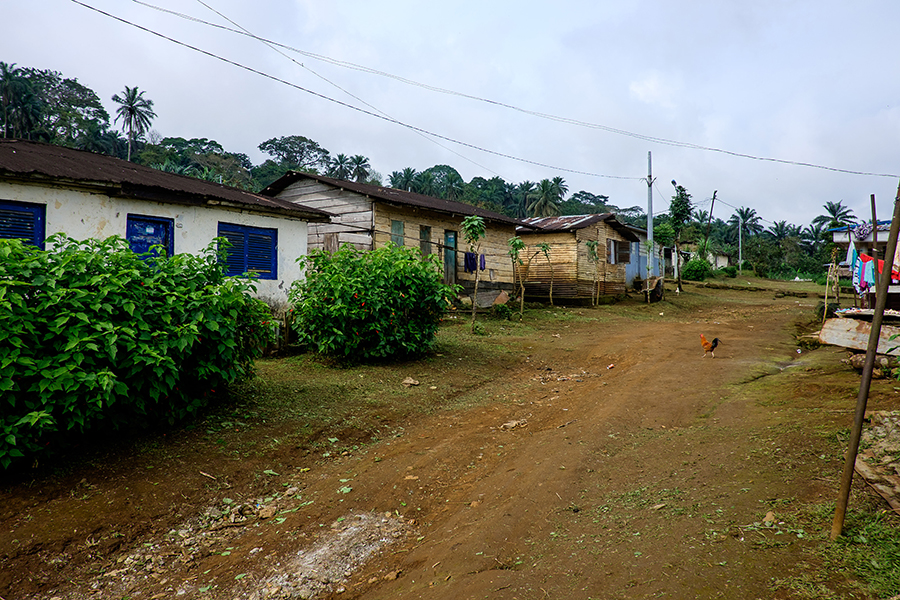
© Jan Ziegler / Shutterstock
The case study below is a fictional one that provides some background when a CRM does not exist.
|
Activity 4.8 Case Study - Amadi Read about Amadi and then answer the questions that follow. Amadi is a 35-year-old staff member for a small community-based organisation (CBO) providing basic services. He spends much of his time in remote villages distributing items such as food, clothing, and medical supplies. A British International Non-Governmental Organisation (INGO) funds his programme activities and covers his salary. The INGO value Amadi and his CBO as they have direct contact with the community, they speak the local language, and are familiar with the local terrain and customs. Amadi gets along very well with the international staff of the INGO. The INGO staff enjoy his company when they go to the field with him and do not question him when he stays out late and doesn’t follow behaviour protocols. The INGO makes safeguarding a priority: Their safeguarding policy is posted in prominent locations in English and local languages. The local language policy is shared with all partners, who have to sign a Memorandum of Understanding (MoU) that mentions safeguarding and the Code of Conduct. All staff and partners receive regular refresher trainings on its implementation. One day, the village headman hears a rumour that 16-year-old Nala in his village is pregnant. The rumour is that Amadi is the father. The village headman speaks to her parents who are illiterate and do not know what to do about the situation. They were going to send Nala to visit her aunt in the town to have the baby and return when people would have forgotten the rumours. They want Amadi to take responsibility for his actions. There is no complaints response mechanism set up for the community to raise concerns. (Source: Safeguarding report-handling mechanism resource by Bond) Reflect and respond in your learning journal:
|
INGOs should positively collaborate to enable partners (such as CBOs) to work together to openly discuss concerns and incidents and jointly address them. When setting up any project, it’s important for organisations to have a full understanding of the cultural practices in that context to address any harm that may arise.
It is good practice for INGOs to have clear community-based complaints response mechanisms:
- Communities must know what to report and how to report on the conduct of their personnel.
- INGOs should collaborate with partners to develop such CRMs.
- Understand cultural practices without lowering standards of behaviour.
- Have strong relationships with community and religious leaders.
If the INGO and the CBO had been collaborating with the village head and community leaders closer to develop the CRM, reporting of inappropriate behaviour may have happened earlier and perhaps even prevented the rape from occurring. This situation could have been prevented by closer supervision of staff and partners and having in place a safeguarding focal point where concerns of Amadi’s inappropriate behaviour could have been reported to prior to the sexual abuse.
Training all staff and associated personnel on safeguarding is essential so that they know what the signs and symptoms are to look out for and how to raise concerns. Such cases are often criminal in many countries, however, if the victims and/or their family fails to report the matter using either the CRM or by other means, these cases are not pursued.
4.16 Reflecting on complaints response mechanisms in your organisation

© fstop123 / iStock / Getty Images Plus.
|
Reflect on what complaints response mechanism exists in your organisation for safeguarding concerns from beneficiaries or community members to be reported?
|
4.17 Unit 4 Knowledge check
The end-of-unit knowledge check is a great way to check your understanding of what you have learnt.
There are five questions, and you can have up to 3 attempts at each question depending on the question type. The quizzes at the end of each unit count towards achieving your Digital Badge for the course. You must score at least 80% in each quiz to achieve the Statement of Participation and Digital Badge.
4.18 Review of Unit 4

© Feodora Chiosea / iStock / Getty Images Plus.
Congratulations on reaching the end of Unit 4!
You began by revisiting the safeguarding cycle and thinking about the importance of having effective reporting mechanisms. You considered the barriers that can prevent different kinds of people from reporting safeguarding concerns and what your organisation could do to overcome them.
You then reflected on reporting procedures within your own organisation and learnt about your responsibilities to complainants with an emphasis on the importance of confidentiality.
You studied some case studies, identifying what can happen when reporting procedures are ineffective, before designing and reflecting on what a reporting procedure should look like.
|
Reflect and respond in your learning journal:
In the next unit, you will be learning about organisational responses to safeguarding. To help you prepare consider the following questions: What are appropriate responses when concerns are reported, and what do those next steps look like? |
Now go to Unit 5: Response.
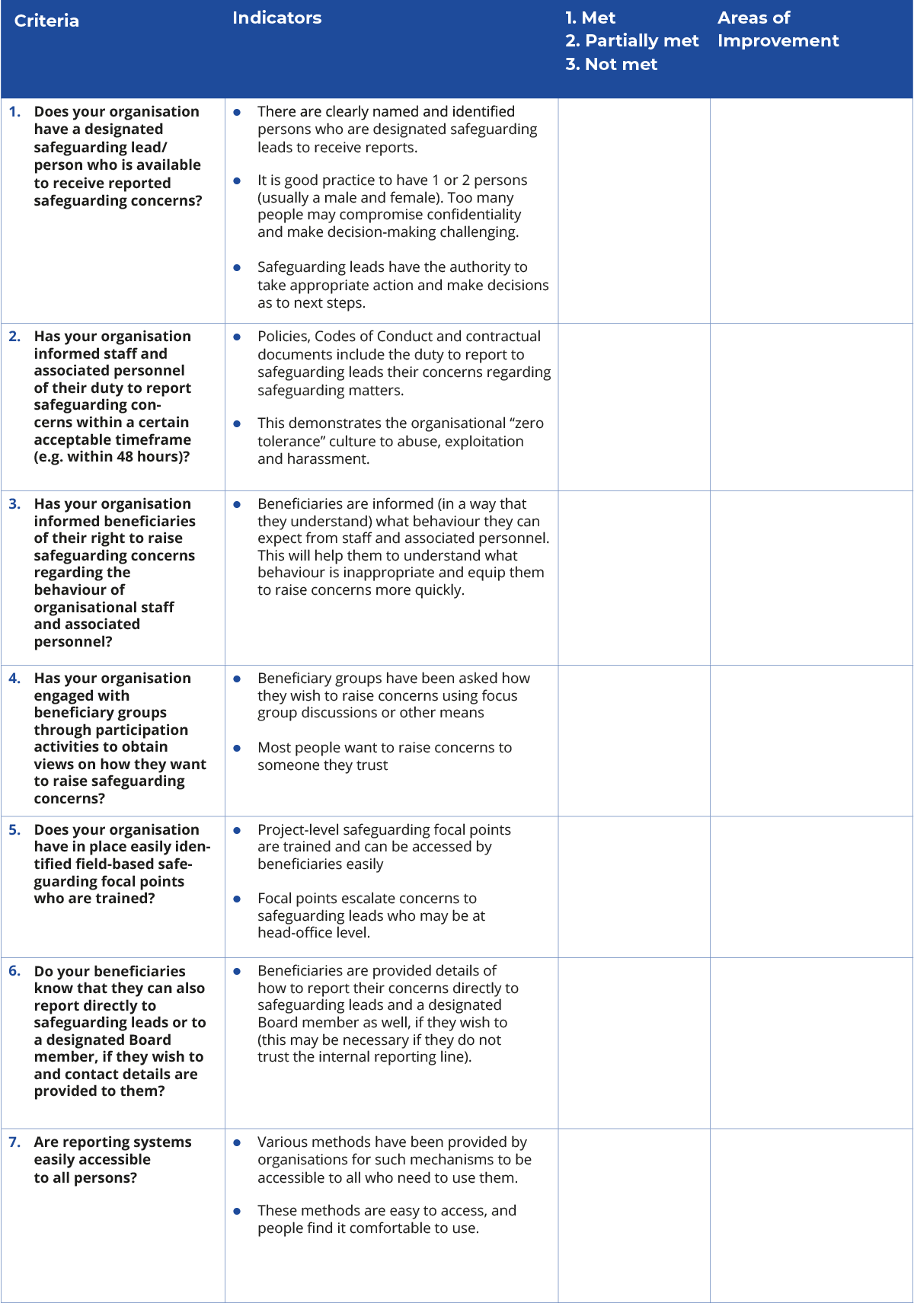 © (Adapted from FCDO’s Enhanced Due Diligence Standards. Reproduced under the terms of the OGL)
© (Adapted from FCDO’s Enhanced Due Diligence Standards. Reproduced under the terms of the OGL)